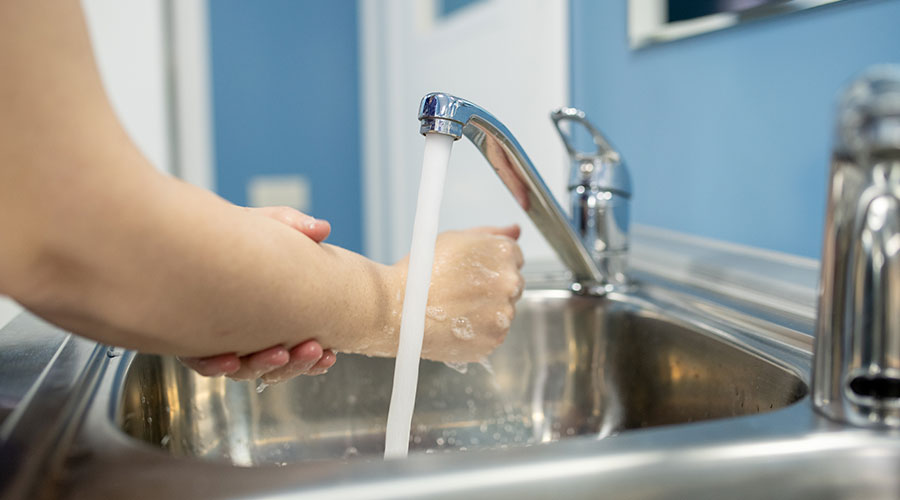Handwashing sinks have been a target for infection control improvement in hospitals and other healthcare facilities. Their designs bring potentially high concentrations of healthcare pathogens — nontuberculous mycobacteria, Pseudomonas aeruginosa and other Gram-negative bacteria — close to patients, healthcare professionals and fomites, which are inanimate objects that can transfer infectious agents to a new host.
Handwashing only accounted for four percent of sink activities, according to a study that analyzed the number of different activities performed at or near handwashing sinks in patient rooms. Other activities were associated with medical care, placing items near the sink, patient nutrition and environmental cleaning.
Splash zones and CMS guidance
A splash zone is the area around a sink where contamination could occur to objects within that space if they become wet due to handwashing or other activities. Splashing can occur up to about three feet from the sink. A more rigorous hand wash could potentially distribute droplets farther, but for purposes of surveying healthcare facilities, Centers for Medicare and Medicaid Services (CMS) uses three feet as the guide.
According to the CMS survey form, medications should not be prepared near areas of splashing water, such as within three feet of a sink. When space around a sink is limited, a vertical splash guard can be mounted beside it.
Outbreaks have been associated with the preparation of medication close to sinks. One such outbreak was reported in the publication, Outbreak of Mycobacterium mucogenicum Bloodstream Infections Among Patients with Sickle Cell Disease in an Outpatient Setting.
Tap water from two sinks was implicated in the outbreak. A nurse in the clinic had prepared intravenous port flushes on the sink counter, using a saline bag that was hanging over the sink, throughout the shift instead of using prefilled saline flushes. The same sink was used for handwashing.
Splashed water near sinks also can play a part in contaminating nearby medical supplies, a patient’s toothbrush or equipment used by nursing staff. CMS recommends not to store anything in the splash zone.
Changing rooms or protocols
Perhaps an environmental services manager cannot change where a sink is located, but they can alter activities that occur around the sink. For example, consider giving patients a new hospital-supplied toothbrush each day with instructions to dispose of it after one use. That practice will reduce infection or contamination from the sink or toilet.
Train caregivers not to use countertops adjacent to handwashing sinks as sterile prep areas. Encourage them to use single-use carts, making sure that they do not park them next to the handwashing sink and that they disinfect them after each use. Ask patients and their families to keep the bathroom door closed while flushing and when not being used.
As more managers have become aware of the potential for bacteria and superbug contamination from plumbing systems, the industry is responding by developing new fixtures and systems that reduce or eliminate the potential of infection. These include implementing ultraviolet lights, low-splash sinks and low-exhaust fixtures, as well as automatic injection of sanitizing agents.
J. Darrel Hicks, BA, MESRE, CHESP, Certificate of Mastery in Infection Prevention, is the past president of the Healthcare Surfaces Institute. Hicks is nationally recognized as a subject matter expert in infection prevention and control as it relates to cleaning. He is the owner and principal of Safe, Clean and Disinfected. His enterprise specializes in B2B consulting, webinar presentations, seminars and facility consulting services related to cleaning and disinfection. He can be reached at darrel@darrelhicks.com, or learn more at www.darrelhicks.com.

 Contaminants Under Foot: A Closer Look at Patient Room Floors
Contaminants Under Foot: A Closer Look at Patient Room Floors Power Outages Largely Driven by Extreme Weather Events
Power Outages Largely Driven by Extreme Weather Events Nemours Children's Health Opens New Moseley Foundation Institute Hospital
Nemours Children's Health Opens New Moseley Foundation Institute Hospital Code Compliance Isn't Enough for Healthcare Resilience
Code Compliance Isn't Enough for Healthcare Resilience Ribbon Cutting Marks First Phase Completion for New Montefiore Einstein Facility
Ribbon Cutting Marks First Phase Completion for New Montefiore Einstein Facility